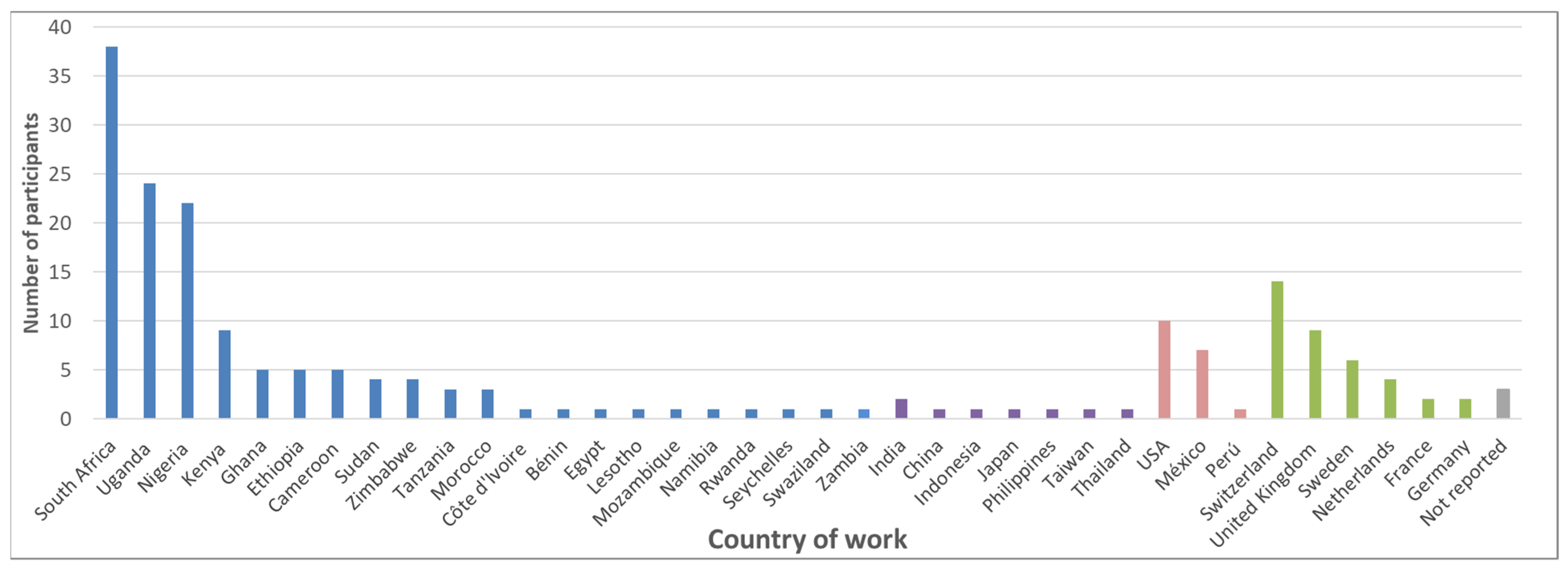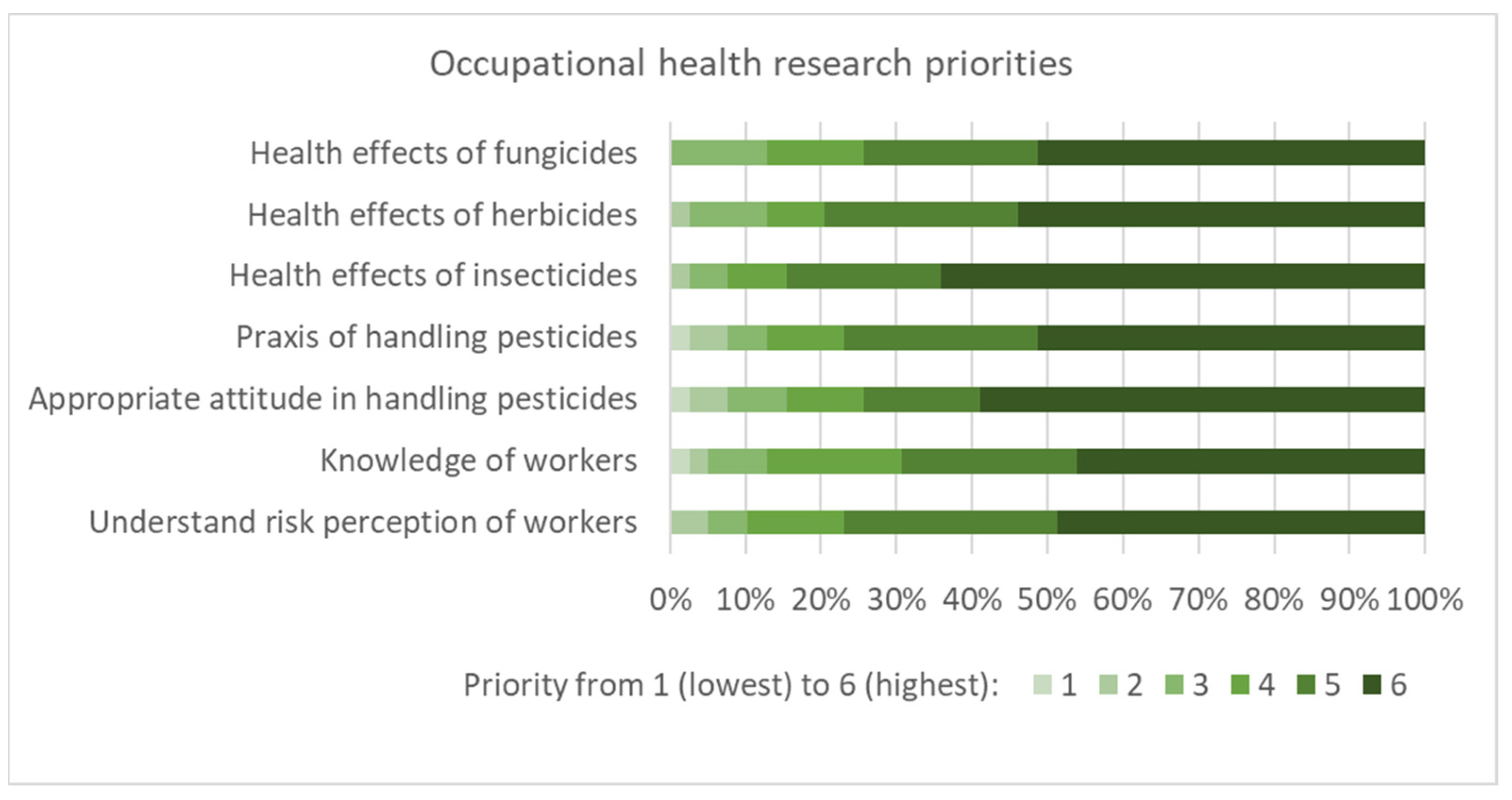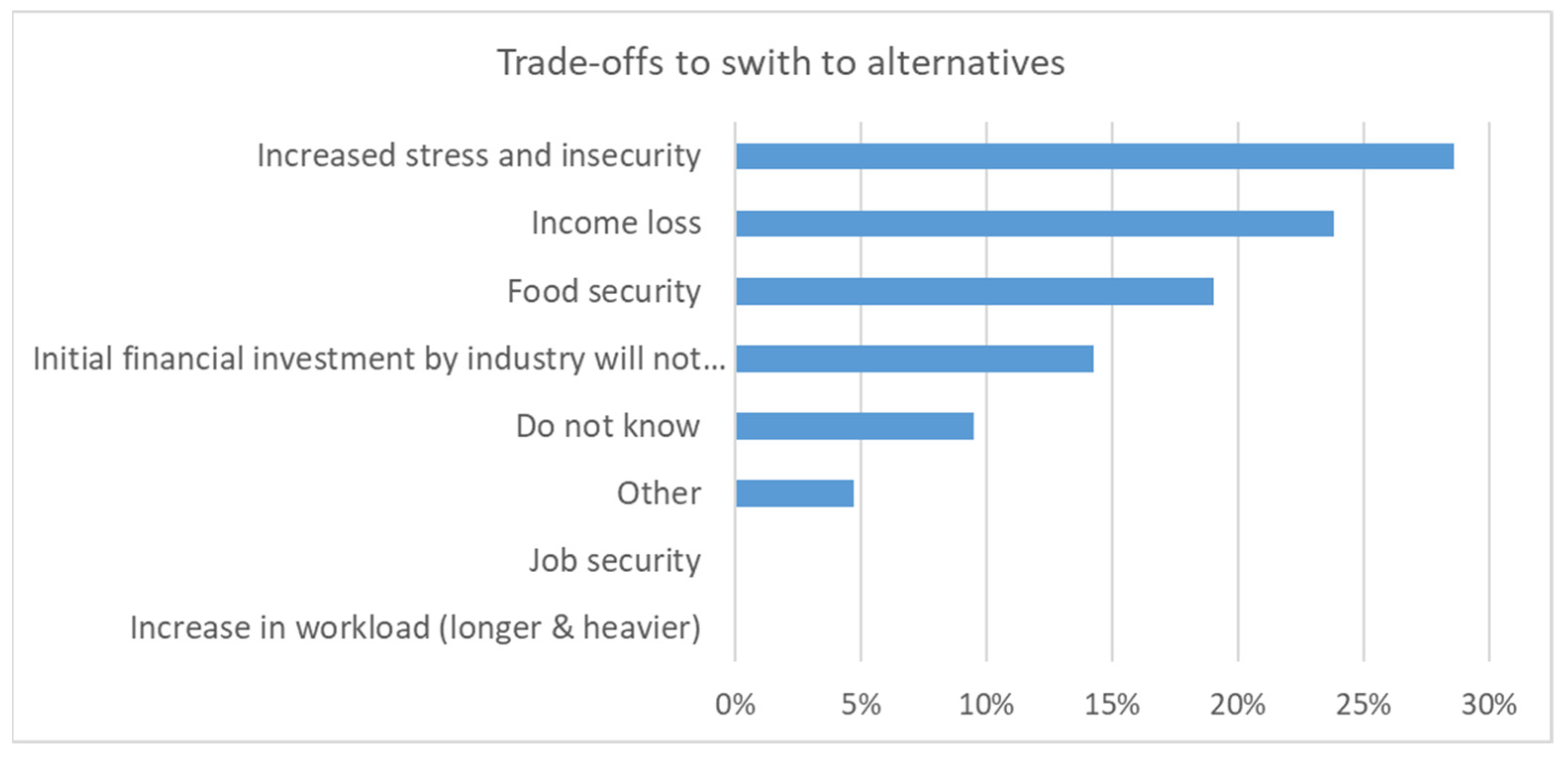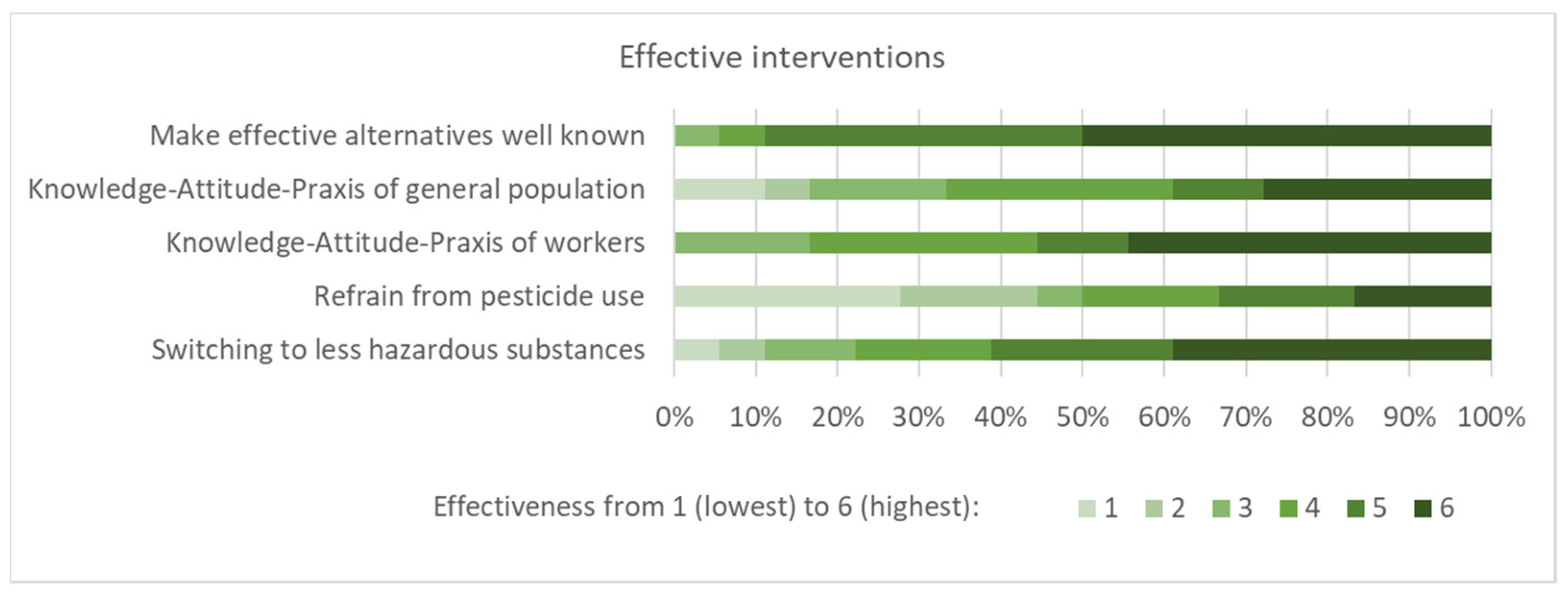Interventions to Reduce Pesticide Exposure from the Agricultural Sector in Africa: A Workshop Report
Abstract
:1. Introduction
2. Materials and Methods
2.1. Workshop Preparation
2.2. Workshop Participants
3. Results
3.1. Occupational Pesticide Exposure
3.1.1. Problems in the Occupational Setting
3.1.2. Case Studies
3.1.3. Discussion of Promoters and Barriers to Switching to Alternatives
3.2. Environmental and Public Pesticide Exposure
3.2.1. Problems for the Environment and Public Exposure
3.2.2. Case Studies
3.2.3. Discussion of Interventions
3.3. Policy Measures
3.3.1. Evidence Needs from a Stakeholder Perspective
3.3.2. Illegal and Street Pesticides
3.3.3. What Policy Is Needed?
3.3.4. Discussion of Stakeholder Perspectives and Policy Options
4. Discussion
5. Conclusions
Author Contributions
Funding
Institutional Review Board Statement
Informed Consent Statement
Data Availability Statement
Conflicts of Interest
References
- De Graaff, J.; Kessler, A.; Nibbering, J.W. Agriculture and food security in selected countries in Sub-Saharan Africa: Diversity in trends and opportunities. Food Secur. 2011, 3, 195–213. [Google Scholar] [CrossRef] [Green Version]
- AGRA. Partnership for Inclusive Agricultural Transformation in Africa (PIATA). Available online: https://agra.org/piata/ (accessed on 18 July 2022).
- Shimada, G. The Impact of Climate-Change-Related Disasters on Africa’s Economic Growth, Agriculture, and Conflicts: Can Humanitarian Aid and Food Assistance Offset the Damage? Int. J. Environ. Res. Public Health 2022, 19, 467. [Google Scholar] [CrossRef]
- Ngowi, A.; Mrema, E.; Kishinhi, S. Pesticide Health and Safety Challenges Facing Informal Sector Workers: A Case of Small-scale Agricultural Workers in Tanzania. New Solut. 2016, 26, 220–240. [Google Scholar] [CrossRef] [PubMed]
- SAICM. Strategy to Address Highly Hazardous Pesticides in the Context of the Strategic Approach to International Chemicals Management. 2019. Available online: http://www.saicm.org/Portals/12/Documents/EPI/HHP%20strategy%20English.pdf (accessed on 18 July 2022).
- WHO. Global Situation of Pesticide Management in Agriculture and Public Health: Report of a 2018 WHO-FAO Survey; WHO: Geneva, Switzerland, 2019. [Google Scholar]
- Sosan, M.B.; Akingbohungbe, A.E. Occupational Insecticide Exposure and Perception of Safety Measures among Cacao Farmers in Southwestern Nigeria. Arch. Environ. Occup. Health 2009, 64, 185–193. [Google Scholar] [CrossRef] [PubMed]
- Ndayambaje, B.; Amuguni, H.; Coffin-Schmitt, J.; Sibo, N.; Ntawubizi, M.; Van Wormer, E. Pesticide Application Practices and Knowledge among Small-Scale Local Rice Growers and Communities in Rwanda: A Cross-Sectional Study. Int. J. Environ. Res. Public Health 2019, 16, 4770. [Google Scholar] [CrossRef] [Green Version]
- Andrade-Rivas, F.; Rother, H.A. Chemical exposure reduction: Factors impacting on South African herbicide sprayers’ personal protective equipment compliance and high risk work practices. Environ. Res. 2015, 142, 34–45. [Google Scholar] [CrossRef] [PubMed] [Green Version]
- Teklu, B.M.; Adriaanse, P.I.; Van den Brink, P.J. Monitoring and risk assessment of pesticides in irrigation systems in Debra Zeit, Ethiopia. Chemosphere 2016, 161, 280–291. [Google Scholar] [CrossRef]
- Teklu, B.M.; Adriaanse, P.I.; Ter Horst, M.M.S.; Deneer, J.W.; Van den Brink, P.J. Surface water risk assessment of pesticides in Ethiopia. Sci. Total Environ. 2015, 508, 566–574. [Google Scholar] [CrossRef]
- Chetty-Mhlanga, S.; Fuhrimann, S.; Basera, W.; Eeftens, M.; Röösli, M.; Dalvie, M.A. Association of activities related to pesticide exposure on headache severity and neurodevelopment of school-children in the rural agricultural farmlands of the Western Cape of South Africa. Environ. Int. 2020, 146, 106237. [Google Scholar] [CrossRef]
- Sosan, M.B.; Akingbohungbe, A.E.; Ojo, I.A.O.; Durosinmi, M.A. Insecticide residues in the blood serum and domestic water source of cacao farmers in Southwestern Nigeria. Chemosphere 2008, 72, 781–784. [Google Scholar] [CrossRef]
- Dalvie, M.A.; Sosan, M.B.; Africa, A.; Cairncross, E.; London, L. Environmental monitoring of pesticide residues from farms at a neighbouring primary and pre-school in the Western Cape in South Africa. Sci. Total Environ. 2014, 466, 1078–1084. [Google Scholar] [CrossRef] [PubMed]
- Ihedioha, J.N.; Ejalonibu, M.A.; Ekere, N.R. Multi-residue Analysis of Organochlorine Pesticides in Cocoa Beans (Theobroma cacao) and Soils from Ondo, Nigeria. Pak. J. Anal. Environ. Chem. 2020, 21, 219–231. [Google Scholar]
- Sulaiman, M.; Maigari, A.; Ihedioha, J.; Lawal, R.; Gimba, A.; Shuaibu, A. Levels and health risk assessment of organochlorine pesticide residues in vegetables from Yamaltu area in Gombe, Nigeria. Fr.-Ukr. J. Chem. 2021, 9, 19–30. [Google Scholar] [CrossRef]
- Kapeleka, J.A.; Sauli, E.; Sadik, O.; Ndakidemi, P.A. Co-exposure risks of pesticides residues and bacterial contamination in fresh fruits and vegetables under smallholder horticultural production systems in Tanzania. PLoS ONE 2020, 15, e0235345. [Google Scholar] [CrossRef] [PubMed]
- Ssemugabo, C.; Guwatudde, D.; Ssempebwa, J.C.; Bradman, A. Pesticide Residue Trends in Fruits and Vegetables from Farm to Fork in Kampala Metropolitan Area, Uganda—A Mixed Methods Study. Int. J. Environ. Res. Public Health 2022, 19, 1350. [Google Scholar] [CrossRef] [PubMed]
- Nuapia, Y.; Chimuka, L.; Cukrowska, E. Assessment of organochlorine pesticide residues in raw food samples from open markets in two African cities. Chemosphere 2016, 164, 480–487. [Google Scholar] [CrossRef] [PubMed]
- Galani, J.H.Y.; Houbraken, M.; Wumbei, A.; Djeugap, J.E.; Folio, D.; Spanoghe, P. Evaluation of 99 Pesticide Residues in Major Agricultural Products from the Western Highlands Zone of Cameroon Using QuEChERS Method Extraction and LC-MS/MS and GC-ECD Analyses. Foods 2018, 7, 184. [Google Scholar] [CrossRef] [Green Version]
- Galani, Y.J.H.; Houbraken, M.; Wumbei, A.; Djeugap, J.F.; Fotio, D.; Gong, Y.Y.; Spanoghe, P. Monitoring and dietary risk assessment of 81 pesticide residues in 11 local agricultural products from the 3 largest cities of Cameroon. Food Control 2020, 118, 107416. [Google Scholar] [CrossRef]
- Galani, Y.J.H.; Houbraken, M.; Wumbei, A.; Djeugap, J.F.; Fotio, D.; Gong, Y.Y.; Spanoghe, P. Contamination of Foods from Cameroon with Residues of 20 Halogenated Pesticides, and Health Risk of Adult Human Dietary Exposure. Int. J. Environ. Res. Public Health 2021, 18, 5043. [Google Scholar] [CrossRef]
- Sosan, M.B.; Adeleye, A.O.; Oyekunle, J.A.O.; Udah, O.; Oloruntunbi, P.M.; Daramola, M.O.; Saka, W.T. Dietary risk assessment of organochlorine pesticide residues in maize-based complementary breakfast food products in Nigeria. Heliyon 2020, 6, e05803. [Google Scholar] [CrossRef]
- Odewale, G.O.; Sosan, M.B.; Oyekunle, J.A.O.; Adeleye, A.O. Assessment of systemic and carcinogenic health risks of persistent organochlorine pesticide residues in four fruit vegetables in south-western Nigeria. Br. Food J. 2022, 124, 1755–1774. [Google Scholar] [CrossRef]
- Afshari, M.; Karimi-Shahanjarini, A.; Khoshravesh, S.; Besharati, F. Effectiveness of interventions to promote pesticide safety and reduce pesticide exposure in agricultural health studies: A systematic review. PLoS ONE 2021, 16, e0245766. [Google Scholar] [CrossRef] [PubMed]
- Fuhrimann, S.; Wan, C.; Blouzard, E.; Veludo, A.; Holtman, Z.; Chetty-Mhlanga, S.; Dalvie, M.A.; Atuhaire, A.; Kromhout, H.; Röösli, M.; et al. Pesticide Research on Environmental and Human Exposure and Risks in Sub-Saharan Africa: A Systematic Literature Review. Int. J. Environ. Res. Public Health 2021, 19, 259. [Google Scholar] [CrossRef]
- FAO; WHO. NSP—International Code of Conduct on Pesticide Management; 2014. Available online: https://www.fao.org/agriculture/crops/thematic-sitemap/theme/pests/code/en/ (accessed on 18 July 2022).
- FAO. Pesticide Registration Toolkit. Available online: https://www.fao.org/pesticide-registration-toolkit/en/ (accessed on 18 July 2022).
- WHO. WHO Recommended Classification of Hazardous Pesticides. Available online: https://www.who.int/ipcs/publications/pesticides_hazard/en/ (accessed on 18 July 2022).
- FAO. Identifying HHPs by FAO and WHO Joint Meeting on Pesticide Management (JMPM) Criteria. Available online: http://www.fao.org/agriculture/crops/thematic-sitemap/theme/pests/code/hhp/en/ (accessed on 18 July 2022).
- Dhananjayan, V.; Jayanthi, P.; Jayakumar, S.; Ravichandran, B. Agrochemicals Impact on Ecosystem and Bio-monitoring. In Resources Use Efficiency in Agriculture; Kumar, S., Meena, R.S., Jhariya, M.K., Eds.; Springer: Singapore, 2020. [Google Scholar] [CrossRef]
- Lebailly, P.; Bouchart, V.; Baldi, I.; Lecluse, Y.; Heutte, N.; Gislard, A.; Malas, J.P. Exposure to Pesticides in Open-field Farming in France. Ann. Occup. Hyg. 2009, 53, 69–81. [Google Scholar] [PubMed]
- Boedeker, W.; Watts, M.; Clausing, P.; Marquez, E. The global distribution of acute unintentional pesticide poisoning: Estimations based on a systematic review. BMC Public Health 2020, 20, 1875. [Google Scholar] [CrossRef]
- Jors, E.; Neupane, D.; London, L. Pesticide Poisonings in Low- and Middle-Income Countries. Environ. Health Insights 2018, 12, 1–3. [Google Scholar] [CrossRef] [Green Version]
- Sapbamrer, R.; Thammachai, A. Factors affecting use of personal protective equipment and pesticide safety practices: A systematic review. Environ. Res. 2020, 185, 109444. [Google Scholar] [CrossRef] [PubMed]
- Dhananjayan, V.; Ravichandran, B.; Panjakumar, K.; Kalaiselvi, K.; Rajasekar, K.; Mala, A.; Avinash, G.; Shridhar, K.; Manju, A.; Wilson, R. Assessment of genotoxicity and cholinesterase activity among women workers occupationally exposed to pesticides in tea garden. Mutat. Res. Genet. Toxicol. Environ. Mutagenesis 2019, 841, 1–7. [Google Scholar]
- Dhaanjayan, V.; Ravichandran, B. Occupational health risk of farmers exposed to pesticides in agricultural activities. Curr. Opin. Environ. Sci. Health 2018, 4, 31–37. [Google Scholar] [CrossRef]
- Venugopal, D.; Karunamoorthy, P.; Beerappa, R.; Sharma, D.; Aambikapathy, M.; Rajasekar, K.; Gaikwad, A.; Kondhalkar, S. Evaluation of work place pesticide concentration and health complaints among women workers in tea plantation, Southern India. J. Expo. Sci Environ. Epidemiol. 2021, 31, 560–570. [Google Scholar] [CrossRef]
- Knipe, D.W.; Gunnell, D.; Eddleston, M. Preventing deaths from pesticide self-poisoning-learning from Sri Lanka’s success. Lancet Glob Health 2017, 5, E651–E652. [Google Scholar] [CrossRef] [Green Version]
- Murray, K.; Jepson, P.C.; Huesing, J. Fall Armyworm for Maize Smallholders in Kenya: An Integrated Pest Management Strategic Plan. 2019. Available online: https://repository.cimmyt.org/bitstream/handle/10883/21259/63345.pdf?sequence=1&isAllowed=y (accessed on 18 July 2022).
- Jepson, P.C.; Murray, K.; Bach, O.; Bonilla, M.A.; Neumeister, L. Selection of pesticides to reduce human and environmental health risks: A global guideline and minimum pesticides list. Lancet Planet Health 2020, 4, e56–e63. [Google Scholar] [CrossRef] [Green Version]
- Jepson, P.C.; Guzy, M.; Blaustein, K.; Sow, M.; Sarr, M.; Mineau, P.; Kegley, S. Measuring pesticide ecological and health risks in West African agriculture to establish an enabling environment for sustainable intensification. Philos. Trans. R. Soc. B: Biol. Sci. 2014, 369, 20130491. [Google Scholar] [CrossRef] [Green Version]
- Diemer, N.; Staudacher, P.; Atuhaire, A.; Fuhrimann, S.; Inauen, J. Smallholder farmers’ information behavior differs for organic versus conventional pest management strategies: A qualitative study in Uganda. J. Clean Prod. 2020, 257, 120465. [Google Scholar] [CrossRef]
- Fuhrimann, S.; Farnham, A.; Staudacher, P.; Atuhaire, A.; Manfioletti, T.; Niwagaba, C.B.; Namirembe, S.; Mugweri, J.; Winkler, M.S.; Portengen, L.; et al. Exposure to multiple pesticides and neurobehavioral outcomes among smallholder farmers in Uganda. Environ. Int. 2021, 152, 106477. [Google Scholar] [CrossRef] [PubMed]
- Staudacher, P.; Fuhrimann, S.; Farnham, A.; Mora, A.M.; Atuhaire, A.; Niwagaba, C.; Stamm, C.; Eggen, R.I.; Winkler, M.S. Comparative Analysis of Pesticide Use Determinants among Smallholder Farmers from Costa Rica and Uganda. Environ. Health Insights 2020, 14, 1–15. [Google Scholar] [CrossRef]
- Atuhaire, A.; Ocan, D.; Jørs, E. Knowledge, attitudes, and practices of tomato producers and vendors in Uganda. Adv. Nutr. Food Sci. 2016, 1, 1–7. [Google Scholar]
- Sosan, M.B.; Oni, O.; Folorunso, D.O. Pesticide handling and associated health risks among agrochemical retailers in Osun State, Nigeria. Ife J. Agric. 2013, 26, 97–110. [Google Scholar] [CrossRef]
- Rodenburg, J.; Johnson, J.M.; Dieng, I.; Senthilkumar, K.; Vandamme, E.; Akakpo, C.; Allarangaye, M.D.; Baggie, I.; Bakare, S.O.; Bam, R.K.; et al. Status quo of chemical weed control in rice in sub-Saharan Africa. Food Secur. 2019, 11, 69–92. [Google Scholar] [CrossRef] [Green Version]
- Mueller, W.; Atuhaire, A.; Mubeezi, R.; van den Brenk, I.; Kromhout, H.; Basinas, I.; Jones, K.; Povey, A.; van Tongeren, M.; Harding, A.H.; et al. Evaluation of two-year recall of self-reported pesticide exposure among Ugandan smallholder farmers. Int. J. Hyg. Environ. Health 2022, 240, 113911. [Google Scholar] [CrossRef]
- Fuhrimann, S.; Van den Brenk, I.; Atuhaire, A.; Mubeezi, R.; Staudacher, P.; Huss, A.; Kromhout, H. Recent pesticide exposure affects sleep: A cross-sectional study among smallholder farmers in Uganda. Environ. Int. 2022, 158, 106878. [Google Scholar] [CrossRef] [PubMed]
- Pacific Northwest Agricultural Safety and Health Center. Bilingual App to Keep Farmworkers Safe. Available online: https://deohs.washington.edu/pnash/blog/bilingual-app-keep-farmworkers-safe (accessed on 18 July 2022).
- Callahan, C.L.; Hamad, L.A.; Olson, J.R.; Ismail, A.A.; Abdel-Rasoul, G.; Hendy, O.; Rohlman, D.S.; Bonner, M.R. Longitudinal assessment of occupational determinants of chlorpyrifos exposure in adolescent pesticide workers in Egypt. Int. J. Hyg. Environ. Health 2017, 220, 1356–1362. [Google Scholar] [CrossRef] [PubMed]
- Rohlman, D.S.; Davis, J.W.; Ismail, A.; Rasoul, G.M.A.; Hendy, O.; Olson, J.R.; Bonner, M.R. Risk perception and behavior in Egyptian adolescent pesticide applicators: An intervention study. BMC Public Health 2020, 20, 678. [Google Scholar] [CrossRef] [PubMed]
- Dabrowski, J.M.; Balderacchi, M. Development and field validation of an indicator to assess the relative mobility and risk of pesticides in the Lourens River catchment, South Africa. Chemosphere 2013, 93, 2433–2443. [Google Scholar] [CrossRef]
- Dabrowski, J.M.; Shadung, J.M.; Wepener, V. Prioritizing agricultural pesticides used in South Africa based on their environmental mobility and potential human health effects. Environ. Int. 2014, 62, 31–40. [Google Scholar] [CrossRef]
- Chetty-Mhlanga, S.; Basera, W.; Fuhrimann, S.; Probst-Hensch, N.; Delport, S.; Mugari, M.; Van Wyk, J.; Röösli, M.; Dalvie, M.A. A prospective cohort study of school-going children investigating reproductive and neurobehavioral health effects due to environmental pesticide exposure in the Western Cape, South Africa: Study protocol. BMC Public Health 2018, 18, 857. [Google Scholar] [CrossRef] [Green Version]
- Molomo, R.N.; Basera, W.; Chetty-Mhlanga, S.; Fuhrimann, S.; Mugari, M.; Wiesner, L.; Röösli, M.; Dalvie, M.A. Relation between organophosphate pesticide metabolite concentrations with pesticide exposures, socio-economic factors and lifestyles: A cross-sectional study among school boys in the rural Western Cape, South Africa. Environ. Pollut. 2021, 275, 116660. [Google Scholar] [CrossRef]
- Dalvie, M.A.; White, N.; Raine, R.; Myers, J.E.; London, L.; Thompson, M.; Christiani, D.C. Long term respiratory health effects of the herbicide, paraquat, among workers in the Western Cape. Occup. Environ. Med. 1999, 56, 391–396. [Google Scholar] [CrossRef] [Green Version]
- Dalvie, M.A.; Myers, J.E.; Thompson, M.L.; Dyer, S.; Robins, T.G.; Omar, S.; Riebow, J.; Molekwa, J.; Kruger, P.; Millar, R. The hormonal effects of long-term DDT exposure on malaria vector-control workers in Limpopo Province, South Africa. Environ. Res. 2004, 96, 9–19. [Google Scholar] [CrossRef]
- Dalvie, M.A.; Naik, I.; Channa, K.; London, L. Urinary dialkyl phosphate levels before and after first season chlorpyrifos spraying amongst farm workers in the Western Cape, South Africa. J. Environ. Sci. Health B 2011, 46, 163–172. [Google Scholar] [CrossRef]
- English, R.G.; Perry, M.; Lee, M.M.; Hoffman, E.; Delport, S.; Dalvie, M.A. Farm residence and reproductive health among boys in rural South Africa. Environ. Int. 2012, 47, 73–79. [Google Scholar] [CrossRef] [PubMed]
- Dalvie, M.A.; Rother, H.A.; London, L. Chemical hazard communication comprehensibility in South Africa: Safety implications for the adoption of the globally harmonised system of classification and labelling of chemicals. Saf. Sci. 2014, 61, 51–58. [Google Scholar] [CrossRef]
- Motsoeneng, P.M.; Dalvie, M.A. Relationship between Urinary Pesticide Residue Levels and Neurotoxic Symptoms among Women on Farms in the Western Cape, South Africa. Int. J. Environ. Res. Public Health 2015, 12, 6281–6299. [Google Scholar] [CrossRef] [Green Version]
- Mwanga, H.H.; Dalvie, M.A.; Singh, T.S.; Channa, K.; Jeebhay, M.F. Relationship between Pesticide Metabolites, Cytokine Patterns, and Asthma-Related Outcomes in Rural Women Workers. Int. J. Environ. Res. Public Health 2016, 13, 957. [Google Scholar] [CrossRef] [Green Version]
- Glass, T.; Dalvie, M.A.; Holtman, Z.; Vorster, A.A.; Ramesar, R.S.; London, L. DNA variants and organophosphate neurotoxicity among emerging farmers in the Western Cape of South Africa. Am. J. Ind. Med. 2018, 61, 11–20. [Google Scholar] [CrossRef] [PubMed] [Green Version]
- Olutona, G.O.; Ayano, S.A.; Obayomi-Davies, O. Organochlorine pesticide in water and bottom sediment from Aiba Reservoir (Southwestern Nigeria). Chem. Ecol. 2014, 30, 513–531. [Google Scholar] [CrossRef]
- Olutona, G.O.; Aderemi, M.A. Organochlorine pesticide residue and heavy metals in leguminous food crops from selected markets in Ibadan. Legume Sci. 2019, 1, e3. [Google Scholar] [CrossRef]
- Shaibu, I. National Agency of Food and Drug Administration and Control (NAFDAC) Bans 30 Agricultural Products. Vanguard, 14 May 2008. [Google Scholar]
- Chikwe, A. National Agency of Food and Drug Administration and Control (NAFDAC) Axes 20 Fast Food Outlets. Task Operators On Good Hygiene Practices. Available online: www.nigeriabestforum.com (accessed on 6 July 2020).
- Olutona, G.O.; Livingstone, S.T. Detection of Organochlorine Pesticide (OCPs) Residues and Trace Metals in Some Selected Malt Drinks in Nigeria. Beverages 2018, 4, 65. [Google Scholar] [CrossRef] [Green Version]
- Fuhrimann, S.; Klanova, J.; Pribylova, P.; Kohoutek, J.; Dalvie, M.A.; Röösli, M.; Degrendele, C. Qualitative assessment of 27 current-use pesticides in air at 20 sampling sites across Africa. Chemosphere 2020, 258, 127333. [Google Scholar] [CrossRef]
- Veludo, A.F.; Martins Figueiredo, D.; Degrendele, C.; Masinyana, L.; Curchod, L.; Kohoutek, J.; Kukucka, P.; Martinik, J.; Pribylova, P.; Klanova, J.; et al. Seasonal variations in air concentrations of 27 organochlorine pesticides (OCPs) and 25 current-use pesticides (CUPs) across three agricultural areas of South Africa. Chemosphere 2022, 289, 133162. [Google Scholar] [CrossRef]
- Curchod, L.; Oltramare, C.; Junghans, M.; Stamm, C.; Dalvie, M.A.; Röösli, M.; Fuhrimann, S. Temporal variation of pesticide mixtures in rivers of three agricultural watersheds during a major drought in the Western Cape, South Africa. Water Res. X 2020, 6, 100039. [Google Scholar] [CrossRef] [PubMed]
- Fuhrimann, S.; Mol, H.G.J.; Dias, J.; Dalvie, M.A.; Röösli, M.; Degrendele, C.; Figueiredo, D.M.; Huss, A.; Portengen, L.; Vermeulen, R. Quantitative assessment of multiple pesticides in silicone wristbands of children/guardian pairs living in agricultural areas in South Africa. Sci. Total Environ. 2022, 812, 152330. [Google Scholar] [CrossRef] [PubMed]
- Donald, C.E.; Scott, R.P.; Blaustein, K.L.; Halbleib, M.L.; Sarr, M.; Jepson, P.C.; Anderson, K.A. Silicone wristbands detect individuals’ pesticide exposures in West Africa. R. Soc. Open Sci. 2016, 3, 160433. [Google Scholar] [CrossRef] [PubMed] [Green Version]
- Degrendele, C.; Klanova, J.; Prokes, R.; Pribylova, P.; Senk, P.; Sudoma, M.; Röösli, M.; Dalvie, M.A.; Fuhrimann, S. Current use pesticides in soil and air from two agricultural sites in South Africa: Implications for environmental fate and human exposure. Sci. Total Environ. 2022, 807 Pt 1, 150455. [Google Scholar] [CrossRef] [PubMed]
- Eskenazi, B.; Marks, A.R.; Bradman, A.; Harley, K.; Barr, D.B.; Johnson, C.; Morga, N.; Jewell, N.A. Organophosphate pesticide exposure and neurodevelopment in young Mexican-American children. Environ. Health Perspect. 2007, 115, 792–798. [Google Scholar] [CrossRef]
- Naidoo, S.; London, L.; Rother, H.A.; Burdorf, A.; Naidoo, R.N.; Kromhout, H. Pesticide safety training and practices in women working in small-scale agriculture in South Africa. Occup. Environ. Med. 2010, 67, 823–828. [Google Scholar] [CrossRef] [Green Version]
- Solomon, G.M.; Moodley, J. Acute chlorpyrifos poisoning in pregnancy: A case report. Clin. Toxicol. 2007, 45, 416–419. [Google Scholar] [CrossRef]
- Mora, A.M.; Hoppin, J.A.; Cordoba, L.; Cano, J.C.; Soto-Martinez, M.; Eskenazi, B.; Lindh, C.H.; de Joode, B.V. Prenatal pesticide exposure and respiratory health outcomes in the first year of life: Results from the infants’ Environmental Health (ISA) study. Int. J. Hyg. Environ. Health 2020, 225, 113474. [Google Scholar] [CrossRef]
- de Joode, V. Aerial Application of Mancozeb and Urinary Ethylene Thiourea (ETU) Concentrations among Pregnant Women in Costa Rica: The Infants’ Environmental Health Study (ISA). Environ. Health Perspect. 2014, 122, A321. [Google Scholar]
- Rother, H.A. Pesticide Vendors in the Informal Sector: Trading Health for Income. New Solut. 2016, 26, 241–252. [Google Scholar] [CrossRef]
- Lee, Y.Y.; Chisholm, D.; Eddleston, M.; Gunnell, D.; Fleischmann, A.; Konradsen, F.; Bertram, M.Y.; Mihalopoulos, C.; Brown, R.; Santomauro, D.F.; et al. The cost-effectiveness of banning highly hazardous pesticides to prevent suicides due to pesticide self-ingestion across 14 countries: An economic modelling study. Lancet Glob. Health 2021, 9, E291–E300. [Google Scholar] [CrossRef]
- Balme, K.H.; Roberts, J.C.; Glasstone, M.; Curling, L.; Rother, H.A.; London, L.; Zar, H.; Mann, M.D. Pesticide poisonings at a tertiary children’s hospital in South Africa: An increasing problem. Clin. Toxicol. 2010, 48, 928–934. [Google Scholar] [CrossRef] [PubMed]
- Rother, H.A. Falling Through the Regulatory Cracks Street Selling of Pesticides and Poisoning among Urban Youth in South Africa. Int. J. Occup. Environ. Health 2010, 16, 202–213. [Google Scholar] [CrossRef]
- Godsmark, C.N.; Rother, H.A. Part of the solution—An engaged scholarship approach for the sustainable reduction of street pesticides and poisonings. Glob. Public Health 2019, 14, 1535–1545. [Google Scholar] [CrossRef] [Green Version]
- London, L.; Bailie, R. Challenges for improving surveillance for pesticide poisoning: Policy implications for developing countries. Int. J. Epidemiol. 2001, 30, 564–570. [Google Scholar] [CrossRef] [PubMed] [Green Version]













Publisher’s Note: MDPI stays neutral with regard to jurisdictional claims in published maps and institutional affiliations. |
© 2022 by the authors. Licensee MDPI, Basel, Switzerland. This article is an open access article distributed under the terms and conditions of the Creative Commons Attribution (CC BY) license (https://creativecommons.org/licenses/by/4.0/).
Share and Cite
Röösli, M.; Fuhrimann, S.; Atuhaire, A.; Rother, H.-A.; Dabrowski, J.; Eskenazi, B.; Jørs, E.; Jepson, P.C.; London, L.; Naidoo, S.; et al. Interventions to Reduce Pesticide Exposure from the Agricultural Sector in Africa: A Workshop Report. Int. J. Environ. Res. Public Health 2022, 19, 8973. https://doi.org/10.3390/ijerph19158973
Röösli M, Fuhrimann S, Atuhaire A, Rother H-A, Dabrowski J, Eskenazi B, Jørs E, Jepson PC, London L, Naidoo S, et al. Interventions to Reduce Pesticide Exposure from the Agricultural Sector in Africa: A Workshop Report. International Journal of Environmental Research and Public Health. 2022; 19(15):8973. https://doi.org/10.3390/ijerph19158973
Chicago/Turabian StyleRöösli, Martin, Samuel Fuhrimann, Aggrey Atuhaire, Hanna-Andrea Rother, James Dabrowski, Brenda Eskenazi, Erik Jørs, Paul C. Jepson, Leslie London, Saloshni Naidoo, and et al. 2022. "Interventions to Reduce Pesticide Exposure from the Agricultural Sector in Africa: A Workshop Report" International Journal of Environmental Research and Public Health 19, no. 15: 8973. https://doi.org/10.3390/ijerph19158973
APA StyleRöösli, M., Fuhrimann, S., Atuhaire, A., Rother, H.-A., Dabrowski, J., Eskenazi, B., Jørs, E., Jepson, P. C., London, L., Naidoo, S., Rohlman, D. S., Saunyama, I., van Wendel de Joode, B., Adeleye, A. O., Alagbo, O. O., Aliaj, D., Azanaw, J., Beerappa, R., Brugger, C., ... Dalvie, M. A. (2022). Interventions to Reduce Pesticide Exposure from the Agricultural Sector in Africa: A Workshop Report. International Journal of Environmental Research and Public Health, 19(15), 8973. https://doi.org/10.3390/ijerph19158973














